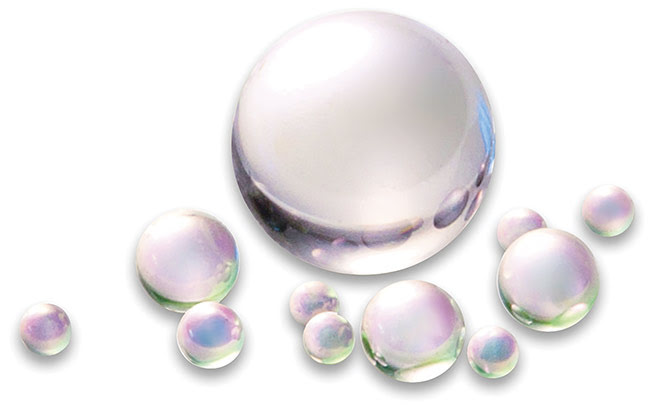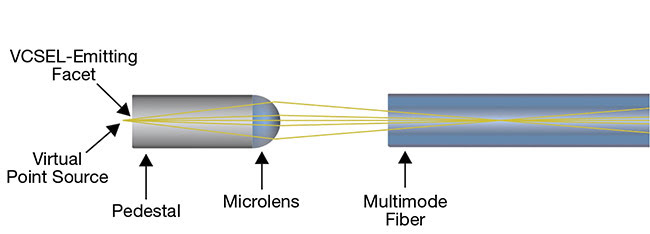As high-bandwidth communications surge, ball lenses offer optimal solutions for today’s data transfer systems.
DONNA HOOKER, DEPOSITION SCIENCES INC.
With the explosion of high-bandwidth communications,
fiber infrastructures are experiencing upgrades that demand improvements in both range and power at the lowest possible SWaP-C (size, weight, power, and cost). As a result, ball lenses — because of their size and cost — are experiencing a resurgence in fiber laser systems for communication and data transfer.

The global connector market will be an $80.4 billion industry by 2023, primarily in the automotive, telecom, and datacom fields (see sidebar). Market growth will drive demand for a wide range of components, as fiber optic configurations vary widely. In any fiber optic assembly, optical system designers have options. They may select from laser, broadband, or LED for the light source, and then choose whether it’s best to couple and collimate it or leave the source uncoupled.
Ball lenses and GRIN (gradient index) lenses are standard options that can be used with fiber-to-fiber, diode-to-fiber,
or diode-to-diode assemblies (Table 1).
Table 1.
Fiber Optic Assembly Components

Ball lenses offer an advantage over GRIN lenses for improving light delivery in some fiber optic assemblies, but coatings are challenging at sizes as small as 0.25 mm. For high-performance, high-volume applications, innovations in conformal coating enable ball and GRIN lenses to significantly improve SWaP-C.
Fiber options
While there are many configurations
in a fiber pigtail assembly, datacom and telecom long-haul modules often use a 1550- or 1310-nm wavelength laser diode-to-fiber configuration, in volumes of 20,000 to 1 million modules per year.
When using fiber, the system designer must decide between single-mode and multimode fiber. While multimode is the lower-cost option, it diffuses laser light, whereas single-mode provides more
coherent light. After selecting the fiber type that best suits the application, the
designer can then determine the numerical aperture and select a ball lens or GRIN lens to match (Figure 1).

Figure 1. Laser-to-multimode fiber coupling.
Coating options
Ball lenses, while providing tangible performance benefits, present coating challenges. One potential option is a low-pressure chemical vapor deposition (LPCVD) coating that overcomes the inherent fixturing challenges of a spherical lens. LPCVD allows for complete 360° conformal coating with no jig marks left by tooling, which makes assembly easier and less expensive for high-volume
applications such as datacom.
When selecting a coating, system designers must consider the trade-off between transmittance and ease of assembly. Ion-beam sputtered coatings provide as high or higher transmittance levels as LPCVD, but the coated parts will have jig lips, which require workarounds in assembly. This will result in additional labor to align the assembly and to ensure transmittance through the coated portion of the ball or GRIN lens.
At lower quantities, additional labor is manageable. At high volume, however, manually aligning components to compensate for jig marks on an assembly line becomes difficult to near impossible. LPCVD offers a uniformity of coating that can reduce assembly time by as much as 30 minutes per system, even allowing for robotic assembly for pick-and-place systems. Ball lenses as small as 0.25 mm can be coated.
In addition to the selection of coating technique, some tricks of the trade in design and assembly can simplify production, reducing total system costs. Consider the following.
Insertion loss due to backreflection: Loss can be reduced over a wide range of wavelengths and incidence angles with multilayer antireflection (AR) coatings. While loss is a larger issue with single-mode fiber, multimode fibers benefit from loss reduction as well.
Centering of the lens: Alignment has a significant impact on coupler efficiency. Consider polarization angle adjustment for maximum power.
Epoxy and other positioning techniques: Positioning techniques can have an impact on total system cost and performance.
Cleaning of connectors before testing: A test-clean-test process and wet-to-dry method are recommended, depending on setup, to reduce contamination, light loss, and reflectance.
The future looks bright for manufacturers in datacom and telecom fiber optics, and smart optical design choices can help to achieve the cost, yield, and performance targets that the market demands.
Images courtesy of Deposition Sciences Inc.
Meet the author
Donna Hooker is global sales and marketing manager for Deposition Sciences Inc. and has 30 years of experience in the photonics industry. She has a bachelor’s degree in mechanical engineering from the University of Rhode Island.
Ball Lenses: Meeting the Demand for High-Speed Data Transfer and Low-Cost Production
Long-awaited growth in fiber optics for telecom and datacom is here, driving demand for ball lenses. IoT, big data, SaaS (software as a service), and an always online, dual-screen culture mean projected steady and significant growth opportunities in fiber optics through 2027.
$80.4B — projected 2023 global connector market
$77B — projected 2023 big data market, driving demand for telecom and datacom
infrastructure upgrades
17% — projected growth rate in fiber optic connectors for automotive by 2027
14% — projected growth rate in fiber optic connectors for telecom and datacom by 2027
Sources: Market Insider, Feb. 2018 Statista